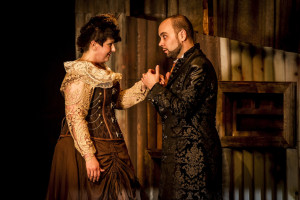How times flies when you are having fun – 10 years since City of Swansea Opera raised the curtain on its first show. How times also flies when you have sold your soul to the Devil as poor old Faust finds out in the Gounod opera of the same name.
For this 10th anniversary production the company chose a Victorian Gothic take on Gounod’s once wildly popular work that is coming back into vogue. This was a brave choice, not only due to the massive individual vocal demands it makes of its principals but also the hit-you-between-the-ears big number demands from voice and orchestra.
The problem of how to have the large vocal impact was solved by the sensible use of local singers and choirs to bulk up the cast. The effect was glorious.
Conductor John Beswick and the small ensemble of musicians brought colour and texture from the melody-rich score allowing the singers to make the evening their own in terms of grabbing the audience’s attention.
The tale of temptation and devotion, lust and sacrifice is played out with this sort of sepia tinted Gothic world with the only flashes of colour being the scarlet lining to Méphistophélès’ hat, for example, and the immoral Marthe’s dress. That role was sung and acted by Caroline Carragher with great aplomb and fun.
Angharad Morgan was vocally a magical Marguerite with a glorious fireworks thrill balanced with gentleness and ultimate pathos in this god-awfully pathetic character’s role. The acting was not sensationally fluid but that could be down to the choice of director Brendan Whatley in making this as much a Victoria melodrama as Gothic horror.
The Faust of the piece was well taken by Alberto Sousa with some eloquent singing and he was given much more to do dramatically as was the case with the particularly rich baritone of Hakan Vramsmo as Valentine. Wagner was brightly sung by Ricardo Panela.
The biggest dramatic role and fun singing came from Mark Saberton’s Méphistophélès, the panto villain of the piece which fitted rather well with this almost Victorian Music Hall boo hiss approach to the opera.
Alexandra Cassidy was a prettily sung Siébel, the lad whose flowers are no substitute for the casket of jewellery given to Marguerite by Faust (and conjured up by Méphistophélès) which prompts the opera’s most famous aria, the Jewel Song. Add to that the uplifting Soldiers’ Chorus, Méphistophélès’ own tingling trills, especially The Song of the Golden Calf, and this is a musically compelling evening.
The Victorian Gothic approach to the design was perfectly good although Marguerite’s costume did rather restrict her movement. Well, it seemed so to me, but again that may have been deliberate, and the hat hid her face. Once in her fallen woman clothes she could let it all go a bit more and her mad scene was nicely delirious.
I am not so sure about the corrugated iron set, including a corrugated cross, which was supplied by the Swansea film company that makes the US/UK series that set in Renaissance Italy, Da Vinci’s Demons. I have struggled to think why the characters live in a sort of metal shanty town but I am sure the answer is out there somewhere. But this was a night for the ears rather than the eyes so I didn’t spend too long trying to work it out.
Borough Theatre, Abergavenny
Further performances in Wales at the Ucheldra Centre, Holyhead, May 16 and Taliesin, Swansea, May 28.


